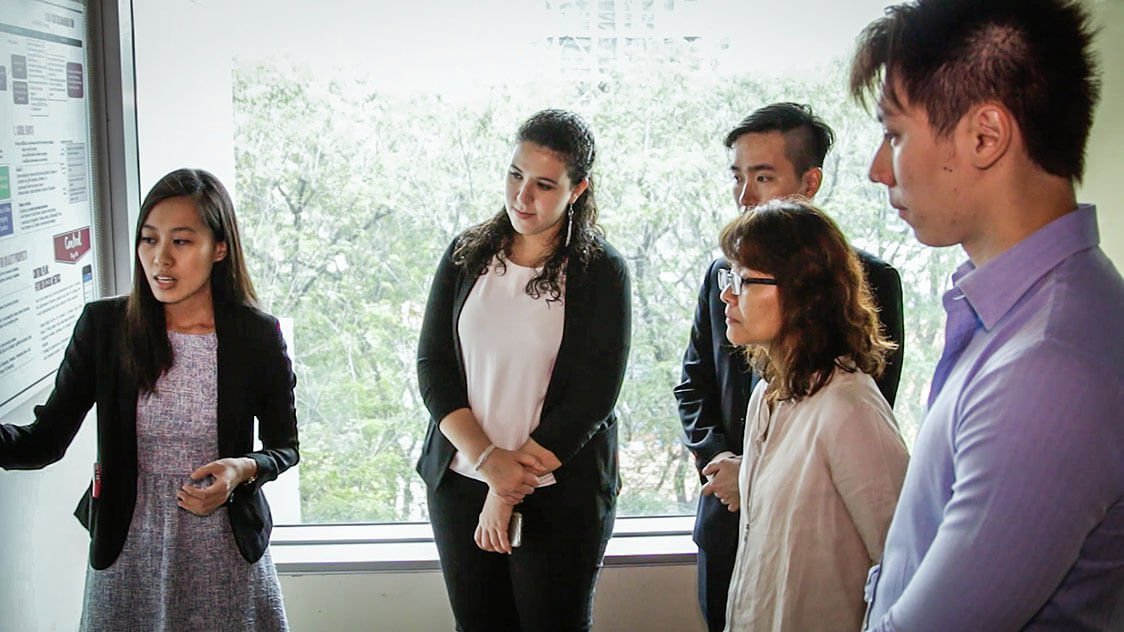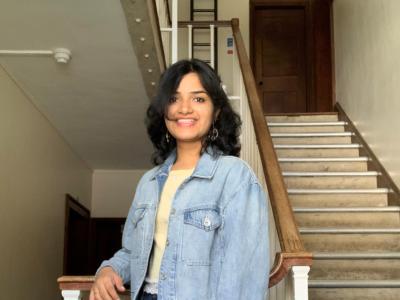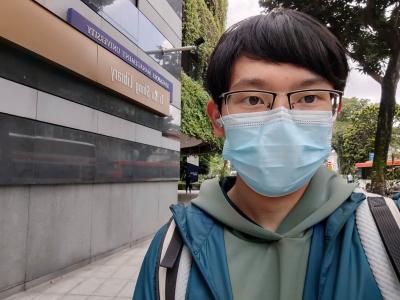
It’s a no-brainer: Would you rather be memorising case studies from a textbook or stepping out and learning through real-world opportunities?
SMU is a pioneer in creating experiences that makes learning relevant to the real world. And this emphasis on self-learning and collaboration with industries is epitomised in the SMU-X Initiative, an experiential learning framework where students take on projects from companies and community organisations.
It is a paradigm shift which focuses on learning, as opposed to teaching, and is a mind-set shift to get the university to collaborate both internally and with its external stakeholders. Each party brings with them their expertise and industry-specific viewpoints in a collaborative approach using both disciplinary knowledge and multi-faceted perspectives.
Quite literally, learning also takes place beyond the classroom: SMU-X electives are conducted in SMU Labs—24/7 flexible learning environments designed for collaborative work. SMU Labs also acts as a test bed for new ideas as well as space-planning to facilitate learning and living by today’s students. More recently, the initiative has included an SMU-X Overseas programme, through collaborations between SMU and overseas partner universities and organisations.
We chat with SMU-X Academic Director, Associate Professor Gary Pan, who explains the difference between his faculty’s curriculum and traditional university curricula; and SMU undergraduate Sean Lim, who went on an SMU-X study mission to Brussels, to share more about his unique overseas experience.
SMU-X Academic Director Gary Pan

How different is SMU-X from other traditional university curricula?
Assoc Prof Pan: SMU-X focuses less on content teaching and more on student-centred and learning-focused methodologies.
Students do projects. Yes, all other traditional university curricula also have projects but the main difference between SMU-X and traditional university curricula is that in SMU-X projects, students get to work on a real problem (not a case) and provide solutions to real clients.
They meet up with the clients and stakeholders and get their hands “dirty” to research and test if their suggestions really work.
How does this initiative benefit students?
Assoc Prof Pan: The SMU-X pedagogy engages students in active learning, applying and reflecting.
Students can better understand the theories and frameworks taught in class and supplement them with hands-on learning through real-world application and implementing solutions. This teaches students to be critical thinkers and in the future, effective managers.
In most cases, students also get to learn how to manage uncertainty and adapt to changes.
In the real world, things are subject to constant change, unlike in a school setting—managements change, people change, and directions change.
Students working with real people and in real situations get to learn how to manage these changes and adapt to them. You will hear them complaining about this and that, sometimes even wanting the school to help them solve the problem. But ultimately, they also recognise this prepares them for their work in the future. Through our end-of-the-term feedback surveys, over 90 per cent of the students who took an SMU-X course last term indicated that the experiential learning approach enhanced their problem-solving, analytical reasoning and communications skills. These are all key cognitive competencies which employers look for when hiring.

What benefits do partner organisations and faculty gain through participating in SMU-X?
Assoc Prof Pan: Partner organisations are able to obtain solutions to a business problem, and the interaction with students gives them fresh perspectives and new ideas.
Through the interactions they have with students throughout the term, they also get to identify talents who are a good fit for their organisations.
We have a few students, who through SMU-X courses, managed to get internship opportunities and even job offers from the partner organisations they had worked with.
As a faculty, I have benefitted through offering an SMU-X course too. I get to learn the constraints of the industry and gain rich data and research insights. My role evolved from a transmitter of information to a facilitator of learning. It is fulfilling to see that besides knowledge, I have also managed to pass down life skills to my students and better prepare them for their future.
Why are SMU-X courses are popular and usually oversubscribed?
Assoc Prof Pan: There is a limit to the number of places available for each course to ensure that each student gets the right amount of attention from the faculty and industry partner. A group of four to six participants is also optimal so that everyone in the group can contribute and learn something out of the work together.
Can you share more about the overseas SMU-X programme?
Assoc Prof Pan: SMU-X Overseas courses, which are conducted with the SMU-X pedagogy, integrate classroom-based instruction and overseas hands-on projects. They feature collaboration between SMU, overseas partner universities and organisations as they work with host companies to provide consulting-like analysis and recommendations.
At the end of this programme, SMU student participants will be awarded one SMU credit. Starting Term 2 AY17/18, SMU-X Overseas courses will be launched in Thailand and Israel. More SMU-X Overseas courses are scheduled to be launched in Indonesia, the Philippines, Taiwan and Laos, with more destinations to be added in future.
How has the initiative evolved since it was launched? What has been learned over the past year or so?
Assoc Prof Pan: The initiative started in 2015 with two courses in two schools, reaching about 58 students and working with 11 partner organisations. There are now 38 courses as of December 2017 in all six schools reaching over 3,000 students and working with more than 250 partner organisations.
We have come a long way and realise that implementing change in the university is not so easy. However, it is critical for us to see that the learning environment is changing rapidly and we, as a university, need to react and become more relevant so as to cope with challenges in the disruptive landscape.
It is also very important that the people you involve in this initiative have an open and collaborative mindset. It won’t work if the faculty is not willing to commit the time to mentor students and scope the project; it won’t work if students are not willing to step into an environment with no precedent or right answer; and it won’t work if the partners are not willing to invest the time in students and provide the data and or information needed.
A lot of time and convincing is involved but once the stars are aligned, you will see wonders.
Sean Lim of SMU’s School of Social Sciences is a student who went on the SMU-X study mission to Brussels last year.

Why did you sign up for the study mission?
Sean: A big push factor was that I had just completed the European Union Politics course under the same professor who was heading the study mission. Together with friends who were interested in the course, it made me feel comfortable that I would be working alongside familiar faces.
In what way was it an enriching experience?
Sean: I enjoyed making new friends and working together with them outside a classroom setting.
For school, I found the study mission to be a real-life continuation of the EU Politics course. This is because I had just spent an entire semester studying and reading up on the European Union and the study mission was a fantastic opportunity for me to work and interact with staff from the EU in person.
The study mission is also useful when I enter the workforce as I now have experience working with overseas colleagues who might be from a different culture and background.

Visiting the EU headquarters in Brussels
Would you recommend a similar trip to other students, and why?
Sean: Definitely! It was not all work and no play. I enjoyed seeing the sights and indulging in good food with my classmates throughout the trip.
Most importantly, we learnt how to help each other in order to achieve the deliverables at the end of the trip.
SMU-X sounds so different from traditional academia. How would you describe it to a prospective student?
Sean: You will see your textbook come to life. There are two parts—the first is learning the theories in class. The second part is more exciting, where you use what you learnt in class to help actual, real-life clients with their problem.
Can you provide an example of how you learnt to solve real-world problems through your SMU-X classes?
Sean: As the term implies, “case studies” are events that have happened in the past and are now available for students to reference in seminars.
In an SMU-X course, you are part of the case study! You get to take what you learnt in class and use it out there. Personally, I find that being able to participate in, mould and contribute to a study allowed me to learn in a way that textbooks simply cannot teach you.

Visiting the Singapore Embassy in Brussels
Is it more challenging attending an SMU-X class, since you can’t afford to sit back and be passive?
Sean: The SMU-X course had its challenges. As mentioned, we needed to conduct a study among the ASEAN embassies. Hence, we were tasked to contact the ASEAN ambassadors in Brussels to interview them for the purpose of the study.
Some ambassadors agreed to our request while others rejected. I am thankful that my assigned embassy accepted and I was able to meet the ambassador and collect the information needed for the study.
One of my biggest takeaways was being able to meet with high-level diplomats from across the globe. My fondest memory would be the reception hosted by the Singapore Embassy for us. We got to understand what the Singapore Embassy does in Brussels and I left feeling much at ease with the knowledge that the interests of Singaporeans are well-represented by a strong delegation overseas.
Find out more about the SMU-X Initiative.


